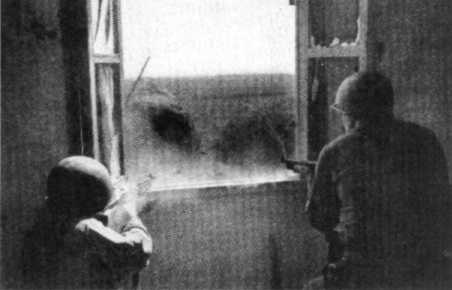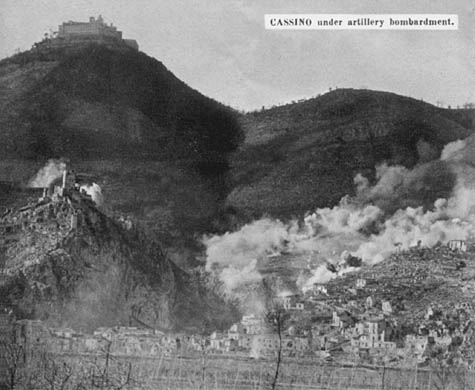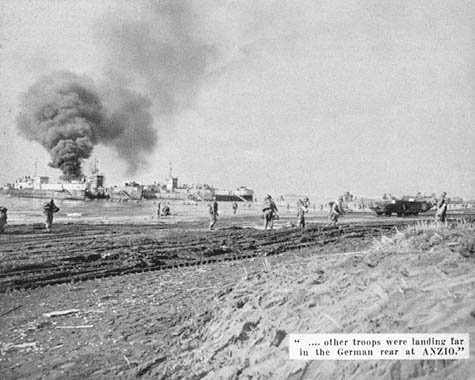While Alexander exhorted Lucas to begin a new offensive and Mackensen prepared for a final, massive assault that would drive the Allies into the sea, one of the most controversial actions of the war was about to be played out 60 miles south, at the once-peaceful Abbey of Monte Cassino. The Right Flank at the Mussolini Canal The ancient abbey sat like a magnificent crown upon a 1,700-foot hill that overlooked the approaches to the Liri Valley. Because of its historical significance (it was begun in 529 AD by St. Benedict), its magnificent collection of priceless works of art, and the fact that it was home to some 2,500 monks, nuns and civilian refugees, Eisenhower had placed the abbey strictly off-limits to Allied bombers and artillery. The Germans, too, had hoped to respect the abbey's importance. But the pronouncements of generals would not be sufficient to spare this treasure. By establishing observation posts and fortified defensive positions outside the abbey's walls, the Germans presented a threat to the Allied push into the Liri Valley that could not be ignored. The 4th Indian Division, given the task of taking Monte Cassino, requested an aerial bombardment of the abbey. After much discussion, which went all the way to Alexander, the request was approved over Clark's objections.  On the morning of February 15, the first wave of bombers unleashed its deadly cargo on the abbey. Ironically, the ruins then provided excellent cover for the Germans, who used them to repulse the 4th Indian Division when it attacked that night. For the next two days, Allied bombs and artillery rained upon the mountaintop, but without gain; the ground troops were unable to evict the German defenders. Bad weather struck, and further offensive operations were postponed. It was becoming ominously clear that the Allies would not be breaking through the Gustav Line any time soon and coming to the rescue of the troops stuck at Anzio.  Shortly after the landings, Hitler became personally involved in events in Italy, giving Kesselring detailed orders long distance as to how to "remove the abcess" from the coast. February 16 was set as the date for the renewed counteroffensive at Anzio with some 125,000 German troops--about 20 percent more than the Allies possessed. Two diversionary attacks were launched, while the main assault came down the Albano-Anzio road toward Maj. Gen. William Eagles' 45th Division. The excellent but raw troops of the Berlin-Spandau Infantry Lehr Demonstration Regiment, which Hitler had ordered to lead the attack, were hard hit and fled for their lives.  But the Germans attacked throughout the night, giving Eagles' men no rest. The next day the Luftwaffe strafed the 45th's positions, and three divisions, supported by 65 panzers, crashed into the Americans, pushing them back to just in front of the Allies' final beachhead line. Then came another wave of air attacks, followed by another charge of infantry and tanks that drove a two-mile-wide wedge into the front. The 45th Division, in the center of the Allied line, was about to crumble. At the crucial moment, Lucas moved in artillery and tanks to plug the gap in his front lines and called for air support and concentrated naval fire to stem the German tide that was about to engulf him. Despite the infusion of Mackensen's reserves and wave after wave of attacking tanks and infantrymen that threw themselves at the 45th Division, the line miraculously held.  Ordering the survivors of his first assault to fight on through the night, Mackensen sent two additional divisions--the 29thPanzergrenadier and 26th Panzer--into battle before first light the next day. This second attack very nearly succeeded, but after four hours of furious combat, the Germans were forced to pull back. On the 22nd, Clark, bowing to pressure from Alexander, reluctantly removed his friend Lucas from command of VI Corps, replacing him with Truscott. Lucas was stunned. "I thought I was winning something of a victory," he wrote, crestfallen, in his diary.  Truscott now placed his own, very different stamp on the command of VI Corps. Instead of installing himself in the musty, underground wine cellar that was Lucas' command post, he made a point of being seen on the front lines, braving enemy fire with the rest of his troops. Morale quickly improved and, as more replacements arrived, a feeling of confidence pervaded the Allied side. On March 29, Allied artillery broke up a strong German assault in front of the 3rd Division before it could get started, and the 3rd counterattacked, putting an end to the Germans' last major offensive.  For the next two months, the Anzio front became static, while both sides reinforced and resupplied themselves. Along the Gustav Line, stalemate was also the name of the game, as four German divisions continued to hold off six Allied divisions around Cassino. But a spring offensive, code-named Diadem, was planned for May, and the Allied commanders hoped it would finally break through both the Gustav Line and the German positions around Anzio. On May 11, a tremendous artillery barrage in the Cassino area heralded the start of Diadem, and the men of the Fifth and Eighth armies began moving. It was the French Expeditionary Force, under General Alphonse Juin, that finally broke the Gustav Line northwest of the Garigliano. Bitter fighting continued along the front, and on the 18th, the heights of Monte Cassino finally fell to the Polish 3rd Carpathian Division.  Success in the south was the signal for Truscott's VI Corps to begin its breakout at Anzio. Clark, fearing the British would beat the Americans to the Eternal City and gain the lion's share of glory, was determined that his Fifth Army, not the British, would be the first army in 15 centuries to capture Rome from the south. For Clark, politics overshadowed military considerations. He therefore directed the seven Allied divisions now at Anzio to begin their breakout, code-named Operation Buffalo--but instead of marching on the town of Valmontone, the VI Corps' objective as specified by Alexander, Clark chose to head for Rome instead. Alexander let him go, but wrote in his memoirs, "I can only assume that the immediate lure of Rome for its publicity value persuaded Mark Clark to switch the direction of his advance."  To effect the breakout, the German stronghold at Cisterna had to be overcome. A massive artillery preparation and hundreds of Allied aircraft pounded the town. When the 3rd Division finally managed to force its way in on May 25, it encountered a determined foe who literally fought to the death. Four months after the initial landings, Cisterna was at last in Allied hands, and Truscott's VI Corps finally linked up with Keyes' II Corps south of Anzio. As evening settled on June 4, a unit from the U.S. 88th Division entered the Piazza Venezia in the heart of Rome. Despite sporadic German resistance, the Americans seized the key bridges, and the rest of VI and II corps took control of the city, with Romans cheering them on. Two days later, events in Normandy swept the Italian theater from the headlines.  For decades, the Anzio operation has generated speculation and argument as to its contribution, relative to its high cost in human lives, to the Allied victory. Certainly the tactical blunders did nothing to shorten the war. Yet, the sacrifice of Allied soldiers at Anzio, the Gustav Line and other bloody points throughout the peninsula kept 24 German combat divisions and other supporting units from being deployed to other fronts, where they conceivably could have been used to devastating effect. |












